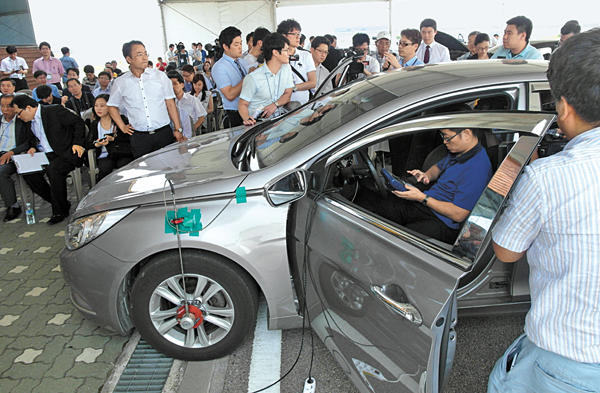Search for cause of acceleration remains stalled

Officials from the special joint investigation team conduct an experiment involving sudden unintended acceleration last week at the Korea Automobile Testing & Research Institute in Hwaseong, Gyeonggi. Provided by the Ministry of Land, Infrastructure and Transport
The Ministry of Land, Infrastructure and Transport conducted a public experiment to try to replicate SUA at the Korea Automobile Testing & Research Institute in Hwaseong, Gyeonggi, last Wednesday and Thursday.
After testing eight theories on the cause of SUA, however, none generated any SUA-related symptoms. The ministry concluded that SUA doesn’t occur given the current level of technology.
The ministry formed a special joint investigation team of government officials and representatives of civic groups, automakers and universities last year to examine car accidents that were suspected to have been caused by SUA.
But after three rounds of investigations, it found no defects that would account for SUA.
However, as public criticism rose, the ministry earlier this month announced it would design the experiments performed last week.
For the reproduction experiment, the ministry formed a 16-member SUA Reproduction Experiment Evaluation Committee. It selected six possible scenarios culled from public suggestions and two others, including a Research Institute for Sudden Unintended Acceleration theory that blamed a pressure surge in a brake booster device.
The team investigated moisture in the engine control unit (ECU), electrical shock in the ECU, pushing the gas and brake pedal at the same time, power generator default of ECU, head and circuit disconnection of the ECU and carbon deposits in a combustor. None of them caused SUA.
To test the pressure surge claim, the team forced open the throttle valve of the vacuum servo system, but no SUA occurred, the ministry said.
The research institute claims that a pressure surge can cause excessive air and fuel to be injected into the engine and that a brake booster vacuum could cause brake failure.
In addition, the ministry said that a faulty gas pedal sensor, which was identified as a possible cause of SUA of Toyota vehicles in the United States four years ago, also didn’t produce SUA as the ECU prevented engine surge.
However, industry observers criticized the ministry’s methods as wrong from the start, since each potential defect was tested individually and only one car was used.
“It’s possible that the chance of SUA occurring is one in 10,000, and it’s nonsense that the ministry has concluded it’s not possible from such limited tests,” said an automotive engineering professor, on condition of anonymity.
Korean drivers also criticized the announcement by the ministry, accusing the government of defending the interests of automakers and wasting taxpayers’ money.
“I can understand that they couldn’t find proper reason, but why should consumers always take 100 percent of responsibility when there is a SUA accident?” read one comment on a local portal Web site.
Data from the Korea Transportation Safety Authority’s automobile default reporting center showed that about 135 cases of suspected SUA were reported last year, while the Korea Consumer Agency received 245 SUA-related complaints in 2012. However, none of them has received compensation or apology from automakers.
Local automakers declined to comment on the ministry’s SUA reproduction test, but they said they respect the ministry’s effort and will continue to work to make vehicles safer.
The ministry, meanwhile, said it will continue to investigate SUA using objective and scientific methods, and ask an unspecified third-party to review its investigation and test results.
BY JOO KYUNG-DON [kjoo@joongang.co.kr]










with the Korea JoongAng Daily
To write comments, please log in to one of the accounts.
Standards Board Policy (0/250자)